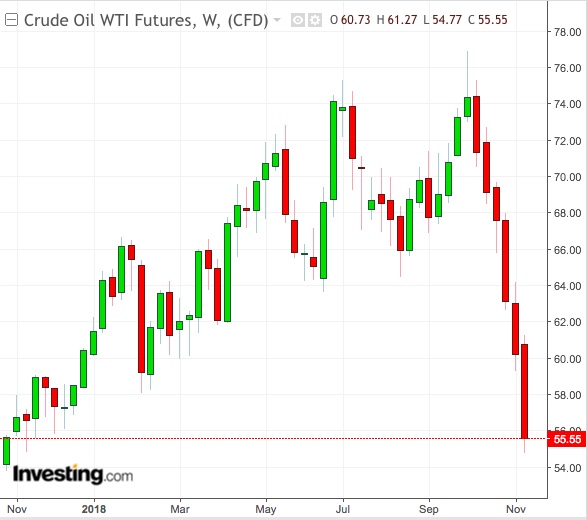December 6 is possibly the most important day in this year’s oil calendar as the Organization of the Petroleum Exporting Countries (OPEC) meets to try and end the most prolonged oil selloff in history. Yet, OPEC may not have the luxury of waiting three weeks if Tuesday’s 7 percent price plunge is any indication of what could happen to the market in the coming days. Tough talk of output cuts, or maybe even an emergency meeting before December 6, could be stronger options.
Dominick Chirichella, an energy markets veteran who’s watched OPEC for the past 35 years, professed surprise at how the 15-member cartel—led by Saudi Arabia and assisted by non-member but major oil producer Russia—has waddled through its latest crisis. He said:
“The way OPEC has worked in the past is to start to hit the market with a series of 30 second news snippets to test the waters as to the different type of strategies they may be considering for an upcoming meeting.”
Chirichella pointed out that when Saudi Arabia first hit the newswires over the weekend, stating it believed supply needs would fall by 1 million per day (bpd) by December and that it will provide half of those cuts, the market replied with Monday's half-hearted rally before the commodity ended lower.
That response, according to the director of risk and trading at the New York-based Energy Management Institute, should have told the Saudis that 1 million bpd “may not be enough of a cut.” Yet, said Chirichella, OPEC proceeded to release on Tuesday a bearish monthly outlook report where it cut 2018 oil demand growth after projecting weaker consumption in the Middle East and China, while raising non-OPEC supply growth for the year. The market’s response? An epic 7 percent drop.
Tuesday’s Plunge Still A Mystery
Some say Tuesday’s plunge wasn’t so much caused by the OPEC report as it was by another outlook from the International Energy Agency (IEA), whose executive director Fatih Birol had implored US oil drillers to further raise their already record high production of crude. The IEA mostly looks after the interests of Western oil importers. Birol suggested the United States over time “add a Russia” worth of 10 million bpd to their current output of 11.6 million bpd.
Phil Davis, who trades both equities and oil at PSW Investments in New York, says rumors that Russia wasn’t on board with the Saudis on the production cuts could have triggered the latest down wave in oil. He added:
“I imagine some large fund was also unwinding a big position, something we will probably hear something about later.”
Some blamed quant or algorithmic trading models that basically sell or buy based on price targets, devoid of fundamentals and emotions. A few cited liquidation activity ahead of the expiration of December options for US crude futures on Wednesday, with traders trying to clear a huge open interest of almost 34,000 lots consisting of puts. Several others said it was the continuation of Monday’s fear factor, caused by US President Donald Trump’s tweet that OPEC should not cut production regardless.
Will Oil Go Under $50 A Barrel Next?
Whatever the trigger, oil prices are off almost 30 percent since hitting four-year highs in early October, on the promise of tight supplies from US sanctions on Iranian oil exports, before collapsing, ultimately due to waivers given by Washington on those sanctions.

US West Texas Intermediate crude hovers at a one-year low of $55 a barrel versus a high of nearly $77 six weeks ago. UK Brent is trading at eight-month lows of around $65. It was at a high of around $87 a month and a half back.
And the selling resumed on Wednesday for a 13th straight day, making it the longest bearish streak on record for oil. The question, of course, was how much lower it could go.
Adam Sarhan of global capital markets fund 50 Park Investments in New York said WTI has “every potential” to break below $50. He added:
“Momentum alone is very bearish and clearly fear of the unknown has taken over. In bear markets, surprises happen to the downside and no move down should be too stunning.”
John Kilduff, partner at New York energy hedge fund Again Capital, concurs. He said:
“On the chart, it shows we should be testing a February low of $52 for WTI. But my basket case is between $46 and $48.”
How Will OPEC React?
The more pertinent questions are: How will OPEC react? And will it wait till December 6?
Phil Flynn of Price Futures Group in Chicago said he was certain OPEC would call an emergency meeting to try and push the market back up. In an email to Investing.com, he wrote:
“They had better do that! Their biggest mistake was not responding to Donald Trump’s last tweet. They made it look like they were scared to cut output and face his fury.”
Kilduff agreed, saying:
“An emergency resolution can’t be ruled out, especially if we get below $50 in the next two days and there’s time for more damage to be done.”
OPEC has held emergency meetings in the past to coordinate price action, but has done so sparingly. Also, with the next scheduled meeting being just three weeks away, it might be hard to get another one organized before that, say analysts who figure that it could take up 10 days to get consensus for a summit. Case in point: the December 6 meeting was originally three days earlier but rescheduled due to conflicts. Kilduff said:
“The other thing they can do is raise the rhetoric—that the forthcoming cuts will be deeper than imagined, perhaps up to 2 million bpd.”
